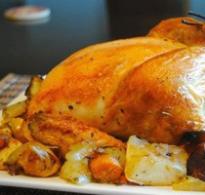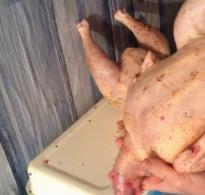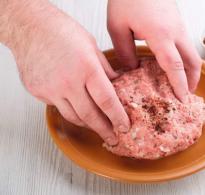Thermal treatment of porcini mushrooms. What to do with mushrooms after picking: processing rules and simple recipes
The stem of the mushroom is cut at the base or, if the mushroom is not familiar enough, carefully pulled out. The lower part of the stem of the fungus is characterized by some signs that make it possible to determine its type, in particular, to distinguish fly agarics (thickness and ring) from edible mushrooms. The leg of the porcini mushroom due to its nutritional value entirely used for food. The legs of honey mushrooms and motley umbrellas are viscous, they can be cut off or broken off from the hat. Not a single mushroom can be sharply pulled out of the ground, because this is applied great harm mycelium.
The mushroom basket should be low and wide. In a tall narrow basket, the mushrooms are wrinkled, and besides, it is difficult to remove them from there. You can also use boxes, but in a mesh or bag, especially made of plastic, the mushrooms crumble.
The knife for picking and cleaning mushrooms should be small and sharp, preferably made of of stainless steel. A dull knife will only crush mushrooms. In the forest, wormholes and other damaged parts are removed, debris and leaves are removed. At home, the mushrooms are once again carefully sorted out, cleaned and prepared for processing.
Sort by type. It is advisable to process and harvest mushrooms by type, because their taste and cooking methods are different.
If there are few mushrooms, then first of all, mushrooms that can be fried fresh should be separated from mushrooms that require heat treatment. It is desirable to distribute the mushrooms in size to facilitate their subsequent processing.
Garbage cleaning. Needles, leaves, moss and other forest debris are cleaned with a wide soft brush, cotton swab or soft cloth. Garbage adhering to the smooth cap of the mushroom is scraped off with a knife. From mushrooms that do not require heat treatment, debris is removed especially carefully, cleaning the folds with a brush, since they are often used dry; unwashed mushrooms are used for frying, drying and baking, or they are quickly washed and dried immediately.
Knife cleaning. With a sharp stainless steel knife, all darkened and softened places are cut out, as well as those parts that are damaged by forest pests. In older tubular fungi cut out the tubular part of the cap. In some mushrooms that have a viscous leg, it is cut off entirely. In russula, oily late and granular, starting from the edges, the skin is removed from the cap, since after heat treatment it becomes mucous.
Washing. Wash and soak the mushrooms as little as possible. Mushrooms that are used for frying or drying are not washed. Mushrooms used for other types of processing are washed quickly cold water and recline on a sieve, sieve or flat board to glass the water. Only mushrooms with an uneven surface - morels, lines. variegated blackberries, etc. - should be washed longer to remove sand adhering to the folds of the cap.
Soaking. Salted mushrooms or mushrooms that have a bitter taste are soaked to improve their taste, dry mushrooms - to restore moisture in them. Washed mushrooms are placed in cold water and soaked until the desired results are obtained, usually within 2-6 hours. When soaking bitter or salty mushrooms, the water is changed every hour so that unwanted substances dissolve faster. The water in which dry mushrooms were soaked is used for food along with the substances dissolved in it. After a long soak, especially if the mushrooms are soaked directly after their heat treatment, many valuable nutrients also dissolve in the water.
Slicing. Washed mushrooms of larger sizes are cut into pieces. White mushrooms, champignons, mushrooms and russula are used together with legs. To make the cooked dish or canned food look more beautiful, the legs of the mushrooms are cooked separately. The mushroom cap is carefully cut into equal pieces - divided into four parts, six parts, etc. The mushroom leg is cut into thin circles, thus breaking the vertically arranged viscous fibers that make it up, and a more tasty mushroom dish is obtained.
Heat treatment. The purpose of cooking mushrooms is to reduce (eliminate) the bitter taste or toxicity. It should be taken into account that heat treatment lowers nutritional value mushrooms and weakens their taste and aroma. Therefore, mushrooms should be used whenever possible without prior heat treatment. In no case should you heat-treat porcini mushrooms, chanterelles, saffron mushrooms, champignons, morels, parasol mushrooms, summer mushrooms and annular caps. Most russula and rows also do not need to be boiled. Chanterelles, annular caps, boletus legs and some other mushrooms become viscous after cooking.
Mushrooms should be cooked, which contain toxic substances that dissolve in water: ordinary lines, russula are burning and brittle, pink waves (volzhanka), yellow and black milk mushrooms. Cook for 15-30 minutes in large numbers water. The broth is drained, as it can cause poisoning of animals.
Because of the bitter taste, many mushrooms require heat treatment: bitters, fiddlers, real milk mushrooms, camphor lactic, alder, sweetish and non-caustic, serushki, white pods, some types of russula, moths, some types of talkers, pigs and many others. It is enough to cook these mushrooms from 5 to 15 minutes so that the bitter taste in them disappears. The unpleasant taste of the gall fungus does not disappear even after cooking.
There are several ways to heat mushrooms:
* Bring the water to a boil, add 1/2 tablespoon of salt to one liter of water. Mushrooms are dipped in boiling water and kept there for 5-15 minutes, then transferred to cold water so that they cool faster.
* Mushrooms are dipped in cold salted water, quickly brought to a boil. After boiling, the dishes are removed from the heat and the mushrooms are allowed to cool in the same water or poured over with clean water.
After the water is drained, the mushrooms are transferred to a cloth bag or on a sieve so that the water is glass. It is not advisable to dry the mushrooms by pressing hard, because in this case many valuable substances are removed from the mushrooms.
Blanching. To maintain integrity and elasticity during the cold method of pickling and pickling, the mushrooms are blanched. This treatment is mainly subjected to russula with a large flat hat, as well as mushrooms. The washed mushrooms are put on a sieve and scalded with water for a few minutes, dipped in boiling water or kept over hot steam. After such a quick heat treatment, the mushrooms become more elastic and, when placed in a storage dish, do not break.
short storage fresh mushrooms. If it is not possible to process the mushrooms on the same day, they are stored for one night (no more!) Cleaned, but not washed or cut. Mushrooms are transferred to a wide basket or some kind of flat dish and stored open in a cool room with plenty of air: in the basement, shed, corridor, etc. Very good place storage is a refrigerator with a temperature of +2--+6°. Mushrooms to be boiled can be poured with cold water. Dishes for soaking should be wide and low. Before processing, the mushrooms should be carefully sorted again and the damaged parts that have arisen during storage should be removed. Previously unnoticed individual wormholes, softened spots and other damage can increase so much during storage that most mushrooms become unfit for consumption.
champignons, russula, chanterelles, mushrooms; marsupials - morels, lines. For enterprises Catering mushrooms come fresh, salted, dried, pickled.
Fresh mushrooms. Mushrooms are immediately processed, as they quickly deteriorate. The primary processing of mushrooms consists of the following operations: cleaning, washing, sorting and cutting.
Porcini mushrooms, boletus, boletus, chanterelles, russula are treated in the same way: they are cleaned of leaves, needles and blades of grass, the lower part of the leg and damaged areas are cut off, the contaminated skin is scraped off and washed thoroughly 3-4 times. When processing russula, the skin is removed from the cap. To do this, they are first scalded with boiling water. They clean the legs and cut off the caps, cut out the damaged and wormy places, remove the mucous skin from the cap and wash it.
Mushrooms are sorted by size into small, medium and large. small mushrooms and caps of medium mushrooms are used whole, large ones are cut or chopped. Porcini mushrooms are poured with boiling water two or three times, the rest of the mushrooms are boiled for 4-5 minutes so that they are soft and do not crumble when cut.
Mushrooms for enterprises come from greenhouses. They should not be overgrown, the plates on the underside of the cap are pale pink. When processing champignons, the film covering the plates is removed, the root is cleaned, the skin is removed from the cap and washed in water with the addition of citric acid or vinegar so that they do not darken.
Morels and lines are sorted out, cut off the roots, put in cold water for 30-40 minutes in order to soak the sand and motes, washed several times. Then the mushrooms are boiled for 10-15 minutes in a large amount of water to destroy and remove the poisonous substance - gelvelic acid, which turns into a decoction during cooking. After boiling, the mushrooms are washed with hot water, and the broth must be poured out.
When processing fresh mushrooms, it is necessary to carefully select them, as some of them resemble inedible and poisonous mushrooms.
Dried mushrooms. Best dried mushrooms- white, as they give a light, fragrant and tasty broth when cooked. Boletus, boletus, boletus darken when dried, so they are of little use for broths. Dried mushrooms are sorted, washed several times, soaked in cold water for 3-4 hours, then the water is drained, filtered and used for cooking mushrooms. Mushrooms are washed after soaking.
Salted and pickled mushrooms. They are separated from the brine, sorted by size and quality, spices are removed, large specimens are cut. Very salty or spicy mushrooms are washed with cold boiled water, sometimes soaked. In order to preserve the good qualities of salted and pickled mushrooms, care must be taken to ensure that the mushrooms are completely covered with brine or marinade before processing.
Below are the waste rates for the mechanical culinary processing of mushrooms (in% of the gross weight):
Fresh porcini mushrooms 24 Marinated porcini mushrooms 18 Fresh champignons 24 Morels 16
Salted mushrooms in barrel containers 18 Salted mushrooms in glass containers 25 Dried mushrooms None Waste for marinade, brine, decoction.
Mid-July - start of the season silent hunting”, as fans of this type of recreation call picking mushrooms. mushroom places are kept secret, and mushroom pickers talk about their prey with no less enthusiasm than fishermen. But between the excitement of collecting and the pleasure of the treat, there is a difficult and not very pleasant stage for processing and harvesting the collected mushrooms. We tell you how to make this process more comfortable.

Immediately upon returning home, mushrooms need sort and prepare for further processing. Need to get fromorzhinki mushrooms and carefully spread on the table. At this stage it is important againevaluate their edibility . For any doubtthrow out suspicious mushrooms, without hesitation!
Mushrooms should be sorted not only depending on the type, but also on intended type of processing. Set aside the ones you are going to dry. Usually noble mushrooms fall into this category: white, young boletus and boletus. These mushrooms should never be washed. They just need to be cleaned with hands from the remnants of the earth, leaves, and throw away the worms.
The rest of the mushrooms are also needed clear from dirt, leaves and moss, assess their condition and throw out the spoiled and wormy ones, after which you need to put them in a container with water. Boletus mushrooms (those in which the inside of the cap is like a “sponge” of the smallest tubes) instantly absorb moisture, so it is better to reduce their soaking to 1-2 minutes, and it is best to just wash it under running water. agaric mushrooms(these include cargo d and, chanterelles, russula) tolerate well even prolonged soaking for a couple of hours. In water, by the way, you can add a spoonful of table salt. The salty environment will cause the death of worms, which can remain in the body of the fungus unnoticed by the human eye.
For any type of preparation (except for drying), mushrooms cost boil. Honey mushrooms are boiled for 45-50 minutes and it is better to do this in two waters, first bring to a boil in one water, then drain it yo and pour a new one, then cook for 45 minutes.Cooking oil takes 30 minutes, white - at least 40 minutes, l chanterelles will require 25 minutes, milk mushrooms, waves and russula - 20-30 minutes. Mushrooms must first be soaked in salt water for 2 hours. VDuring cooking, you need to periodically remove the foam that forms on the surface.
After cooking, the mushrooms need to be thrown into a colander, let the water drain and move on to the next step: frying or canning.
Now let's talk about another version of the workpiece. Dry mushrooms can be done in several ways:
1) in the sun - it is important that the cut pieces do not touch each other;
2) in the oven at a temperature of 45-70 degrees with the door ajar for ventilation;
3) in the microwave - for this you will need to run the cycle at least three times for 20 minutes with five-minute airing pauses.
Cool the dried mushrooms, transfer to a tightly closed jar and store in a closet. Little secret: before preparing sushi dishes yo mushrooms, soak them in warm milk and add a sprig of rosemary to it. Mushrooms will gain unique taste and aroma.
What should you know about mushrooms before going on a "hunt" for them for food purposes? In order for your collected mushrooms to be embodied in delicious dishes at the table, you need to be able to pick mushrooms, process them after picking and cook! We will talk about this today.
In order for the collected mushrooms to be not only a valuable trophy, but also turned into delicious meals, you need to know the rules and sequence of processing mushrooms.
- First, you need to learn to distinguish edible mushrooms from inedible, and especially from poisonous.
- Secondly, it is important to have a clear idea of how to cook this or that “trophy”, because, for example, mushrooms belonging to the so-called conditionally edible species can be eaten only after a special and very careful processing.
- Thirdly, in order to successfully complete the work you have begun and please your family with a delicious dinner, you need to be able to cook mushrooms correctly, for which you should first study which type of mushrooms is best to fry, and from which to cook soup, etc.
The sequence of processing mushrooms after harvest

Sorting mushrooms after picking. Don't Mix Mushrooms Together different types. It is advisable to sort them and use them separately.

Mushroom debris removal. Garbage, needles, leaves from mushrooms can be carefully removed with a soft brush, brush, sponge or cloth.

Washing mushrooms. Wash the mushrooms with cold running water.
How to process and conditionally edible mushrooms after harvest
How to distinguish conditionally edible mushrooms
Is there a difference between poisonous and inedible mushrooms? Isn't it one and the same? No. The fact is that inedible mushrooms do not eat in most cases, not because they can cause great harm to the body, but because of:
- unpleasant taste or smell;
- small fruit bodies;
- pulp stiffness;
- growths on the fruiting body (scales, spikes, etc.);
- specificity of the place of growth;
- rarity.
In addition to the listed parameters, the inedibility of mushrooms can also be expressed in the content of a certain amount of hazardous substances in them. The use of such mushrooms will not lead to a fatal outcome, but it can cause poisoning. Poisonous mushrooms should never be consumed, under any circumstances! Even in the process of cooking and drying, hazardous substances do not evaporate from them, and poisoning with them can lead to death. by the most poisonous mushroom currently is the pale grebe.

This memo will help inexperienced or insecure mushroom pickers to distinguish conditionally edible mushrooms from poisonous ones. Use it when picking mushrooms!
Exists various ways cooking mushrooms. They are boiled, fried, stewed, dried, baked, canned, sauces are prepared from them. Whatever you are going to do with them, do not forget about the pre-treatment of mushrooms - sorting, cleaning from debris, washing, which we talked about above.
Collection rules conditionally edible mushrooms

- never pick old, wormy, diseased mushrooms;
- never take mushrooms grown on the edge or near a highway, railway, factory, etc. The fact is that these gifts of nature, like sponges, absorb all harmful substances from the environment, therefore, in some places, even edible mushrooms, “having eaten » toxins and other dangerous substances that can become poisonous;
- never pick suspicious mushrooms. If there is even the slightest doubt about the edibility of the mushroom, it is better to throw it away;
- do not store mushrooms long time! The sooner you use them for their intended purpose, the less likely they are to go bad and harm your body.
Features of the processing of conditionally edible mushrooms after harvest
You should not deny yourself the pleasure of eating mushrooms that ended up in the column under the heading "Conditionally edible." This name literally means: "edible, but subject to certain conditions." Usually this is a special preparatory treatment, i.e., before preparing a certain dish from mushrooms, they should be boiled, soaked or dried. These methods are presented in strict sequence: as the time for pre-processing mushrooms.

Pre-boiling mushrooms for processing. Cut the carefully selected, washed and peeled mushrooms into pieces and boil for 20 minutes, then drain the water, wash them thoroughly with cold water and boil again for 20 minutes. Be sure to drain the water again, wash the mushrooms with cold water, put them in a colander and you can safely use them for cooking any dishes.

Soaking mushrooms for processing. Pour the mushrooms large quantity cold water and leave for two days. Then drain the water. This must be done without fail, because it takes into itself all the toxic and poisonous substances contained in conditionally edible mushrooms. Wash the mushrooms thoroughly with running water and use as directed.

Drying mushrooms for processing. Hazardous substances can not only be boiled and soaked, but also dried from mushrooms. Why should they be dried outdoors under direct sunlight or in a well-ventilated area directly near a heat source. After reaching fully prepared mushrooms should be removed in a dark place for 2-3 months. You can cook food from them only after such a period.
If you correctly understood how to process mushrooms after harvest and used our tips to distinguish conditionally edible mushrooms, you can not only prepare mushrooms for the winter, but also benefit from mushroom dishes.
kerescan - Oct 16th, 2015
Since ancient times, mushrooms have been harvested for future use. To enjoy mushroom dishes all winter, they were mostly salted and dried. Mushrooms harvested by the proposed methods retain almost all of their useful and taste qualities. They can later be used to prepare various mushroom dishes. Later mushrooms they began to pickle and preserve, hermetically sealing them in glass jars.
Even our ancestors, while harvesting mushrooms, noticed that dried mushrooms are well preserved throughout the winter. This is due to the fact that in mushrooms harvested in this way, only about 24% of moisture is retained. Under such conditions, the vital activity of microorganisms stops or is disturbed. Therefore, dried mushrooms can be consumed without harm to health. The main condition for their storage is the absence of moisture in the room where these mushrooms are located.
During the process of preserving mushrooms, microorganisms are adversely affected by heat, which mushrooms are exposed to when using this method of harvesting them.
During the process, mushrooms are affected not only by high temperature, as in canning, but also acetic acid, and salt, which also adversely affects the state of microorganisms.
During the fermentation process that occurs when pickling mushrooms, lactic acid is formed, which, along with salt, destroys pathogenic microflora.
All edible mushrooms contain many protein compounds, as well as carbohydrates and water. Therefore, in mushrooms a favorable environment is created for the reproduction of various kinds of microorganisms. Because of this, mushrooms do not store longer than a day in fresh. fresh mushrooms, for the same reason, cannot be transported over long distances.
Starting the processing of mushrooms, it is necessary to carefully review each mushroom individually. First of all, this requirement applies to morels and agaric mushrooms. In the pits of morels, small midges often get stuck, and between the plates of the corresponding mushrooms there may be lumps of earth or grains of sand. For processing, mushrooms cleaned from forest debris are used, which must be whole and strong. If worms are found in mushrooms, they are by no means used. Firstly, it spoils the appearance of such blanks, and secondly, in worm mushrooms accumulate toxins that contribute to the poisoning of the body.
If it is necessary to pickle mushrooms and hermetically seal them in jars, it is necessary to use only mushroom caps, only a sock is used for pickling mushrooms, and only a curl is taken from other mushrooms. It is advisable not to preserve all the mushrooms en masse, but to sort them according to their places of growth. This means that mushrooms collected in a spruce forest are rolled up separately from mushrooms collected in a pine forest. Accordingly, they come with mushrooms of different species collected in different forests. When sorting mushrooms, it is necessary to cut and clean the stem of each mushroom separately. In addition, with a knife, they carefully clean the hats from the skin, if necessary, and from various debris. If you come across a mushroom in which the wormhole hit a small part of it, you can cut it out with a knife. If the wormhole has captured half of the fungus, it is better to throw it away. Mushrooms intended for drying do not need to be washed. They are cleaned of debris and each mushroom is individually wiped with a clean, damp cloth. Mushrooms intended for salting, pickling and canning must be thoroughly washed in running water.
How to wash mushrooms.
Not only their safety, but also the health of those who will consume them depends on how thoroughly the mushrooms are washed. Therefore, the process of washing mushrooms should be given special attention and not save water. At the same time, it should be taken into account that prolonged washing causes the loss of aromatic substances present in mushrooms. If it is not possible to rinse the mushrooms in running water, they are washed in a separate container, while changing the water several times. Mushrooms are best washed in running water, as pressurized water removes dirt stuck between the plates and in natural folds well.
See video: How to pre-clean mushrooms (Oil, Polish, chelyshi, aspen, porcini)





